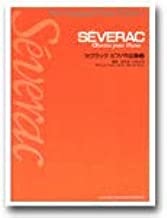Séverac, Déodat de : Suite "En Languedoc"
Work Overview
Publication Year:1905
First Publisher:Édition mutuelle
Instrumentation:Piano Solo
Genre:pieces
Total Playing Time:33 min 30 sec
Copyright:Public Domain
Commentary (1)
Author : Wada, Mayuko
Last Updated: January 1, 2010
[Open]
Author : Wada, Mayuko
Composed between 1903 and 1904. Alongside Chant de la Terre (1900) and Cerdana (1901–1911), it is one of Séverac's important works. The Languedoc region is Séverac's homeland, located between the Rhône and Garonne rivers. It is characterized by picturesque descriptions of nature and scenery, with detailed annotations provided within the piece itself. It displays more refined writing and diverse expression than Chant de la Terre, composed in 1900. Movements 3 and 4, in particular, are masterpieces, and their success further enhanced Séverac's reputation. It is a suite consisting of the following five movements, with a total performance time of approximately 35 minutes.
1. Vers les mas en fête (Towards the Festive Farmhouses)
The beginning of the day. A mountain torrent gains momentum, increasing in volume. The middle section is "Rest at the Spring." The left hand provides propulsion to the floating, swaying triplets. "The Farmhouse on Festival Day" is in 4/4 time. Amidst the lively festival theme, the evening air begins to drift. Finally, "Bells Ringing in the Evening" resound quietly, lulling people into peaceful sleep.
2. Sur l'étang, le soir (On the Pond, in the Evening)
Depicts a nocturnal marsh. In 6/8 time, it maintains a consistently calm tone. An indistinct melody is played as if drifting, but it is crucial to constantly feel the swing provided by the duple-meter rhythm deep within the body. Allowing free variations in this amplitude will add nuance to the piece.
3. À cheval dans la prairie (On Horseback in the Prairie)
Vividly portrays horseback riding in a pasture. It consists of three parts: "Departure," "Rest at the Spring," and "Return Journey." The "Departure" depicts a horse galloping, gradually increasing its excitement. This can be perceived visually on the score and also felt as a physical sensation during performance, making it an enjoyable piece. Be mindful of the drastic dynamic changes in the middle section. Furthermore, the tension and excitement gradually build through sustained notes and the progression of main pitches, and the process leading back to the "horse's gallop" in the "Return Journey" is truly magnificent.
4. Coin de cimetière au printemps (A Corner of the Cemetery in Spring)
Set in a spring cemetery. The inspiration for this piece came in 1897, the year Séverac lost his father and his sister, Marthe. The sorrow is deepened by persistently repeated notes and motifs. Cortot commented on this piece as follows: "Never before had such a deeply moving page been written in French music," and "The melody seems so poignant precisely because it expresses both human suffering and the indifferent clarity of constantly regenerating nature."
5. Le jour de la foire au mas (Market Day at the Farmhouse)
The inserted passages with changing meters and dizzying dynamic shifts add vibrant color to the depiction of a lively market day. The annotations "rustling of bells on livestock" and "crowing of chickens" are also striking. In the latter half, the sound of the Angelus bell is heard from afar, as if interrupting the bustle of the market. The piece then quietly concludes amidst beautiful sounds that seem to dissolve into nature.
(WADA Mayuko, November 2007)
Movements (5)
Coin de cimetiere au printemps
Total Performance Time: 8 min 00 sec






